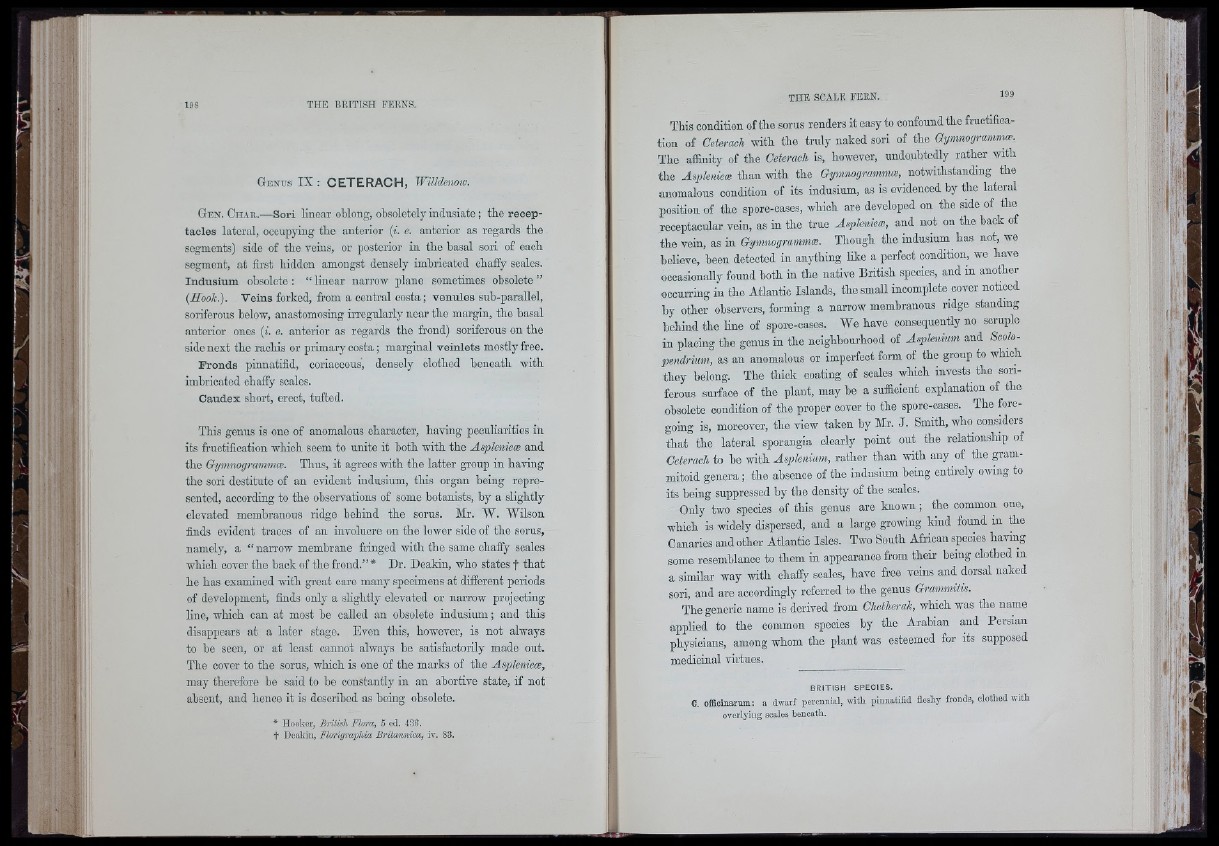
.i '■
i. t
li;
V r
It
198 THE BEITISH FEENS.
G e n u s IX : C E T E R A C H , Willdenow.
G e n . C h a u .—Sori linear oblong, obsolotoly indusiate; the receptacles
lateral, occupying the anterior (i. c. anterior as regards tho
segments) side of the veins, or posterior in the basal sori of oaoh
segment, at first hidden amongst densely imbricated chaffy scales.
Indusium obsolete : “ linear narrow plane sometimes obsolete ”
(Hook.). Veins forked, from a central costa; venules sub-parallel,
soriferous below, anastomosing irregularly near the margin, the basal
anterior ones (*. e. anterior as regards the frond) soriferous on the
side next the raohis or primary costa; marginal veinlets mostly free.
Fronds pinnatifid, coriaooous, densely clothed beneath with
imbricated chaffy scales.
Caudex short, erect, tufted.
This genus is ono of anomalous character, having peculiarities in
its fructification which scorn to unite it both with the Asplenieæ and
the Gyinnogrammæ. Thus, it agrees with the latter group in having
the sori destitute of an evident indusium, this organ heing represented,
according to the observations of some botanists, by a slightly
elevated membranous ridge behind the sorus. Mr. AV. AVilson
finds evident traces of an involucre on the lower side of tho sorus,
namely, a “ narrow membrane fringed with the same chaffy scales
which cover the back of the frond.” * Dr. Dcaldn, who statos f that
he has examined with great care many specimens at different periods
of development, finds only a slightly elevated or narrow projecting
Hne, which can at most he called an obsolete indusium ; and this
disappears at a later stage. Even this, however, is not always
to be seen, or at least cannot always be satisfactorily made out.
The cover to the sorus, which is oue of the marks of the Asplenieæ,
may therefore be said to be constantly in an abortive state, if not
absent, and hence it is described as being obsolete.
* Hooker, British Flora, 5 ed. 436.
t Deakin, Florigraphia Britannica, iv. 83.
This condition of the sorus renders it easy to confound the fructification
of Ceterach with the truly naked sori of the Gymnogrammæ.
The affinity of the Ceterach is, however, undoubtedly rather mth
the AsjileniecB than with the Gymnogrammæ, notwithstanding the
anomalous condition of its indusium, as is evidenced by the lateral
position of the spore-cases, which are developed on the side of the
receptacular vein, as in the true Asplenieæ, and not on the hack of
the vein, as in Gymnogrammæ. Though tho indusium has not, we
believe, been detected in anything Hite a perfect condition, we have
occasionally found both in the native British species, and in another
ocouiTing in the Atlantic Islands, thesmaU incomplete cover noticed
by other observers, forming a narrow membranous ridge standing
behind the Hne of spore-oasos. AVe have consequently no scruple
ill placing the genus in the noighhoui-hood of Asplenium and Scolo-
pendrium, as an anomalous or imperfect form of the group to which
they belong. Tbe thick coating of scales which invests the soriferous
surface of tho plant, may he a sufficient explanation of the
obsolete condition of the proper cover to the spore-cases. The foregoing
is, moreover, the view taken by Mr. J . Smith, who considers
that the lateral sporangia clearly point out the relationship of
Ceterach to be with Asplenium, rather than with any of the gram-
mitoid genera ; the absence of the indusium hoing entirely owing to
its being suppressed by the density of the scales.
Only two species of this gonus aro known ; the common one,
which is widely dispersed, and a large growing kind found in the
Canaries and other Atlantic Isles. Two South African species having
some resemblance to them in appearance from their being clothed in
a similar way with chaffy scales, have free veins and dorsal naked
sori, and are accordingly referred to tho genus Grammüis.
The generic name is derived from Chetherak, which was tho name
applied to the common species by the Arabian and Persian
physicians, among whom the plant was esteemed for its supposed
medicinal virtues.
BRITISH SPECIES.
C. officinarum; a dwarf perennial, with pinnatifid fleshy fronds, clothed with
overlying scales beneatli.
R to'
•Ml
H i '
k
! .
< . I
ri: ikR
m Mlk! r
If. I ,
t k v i